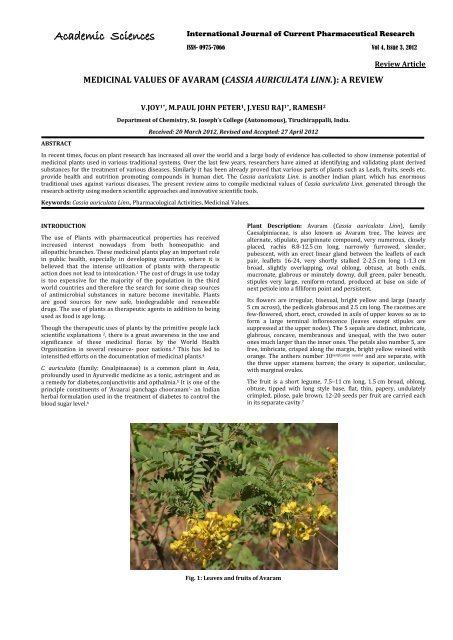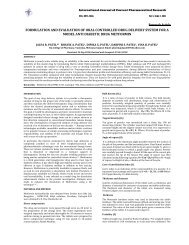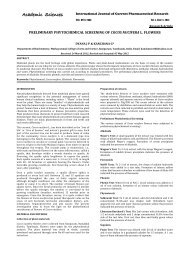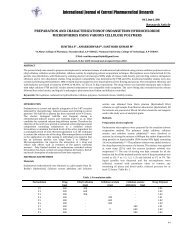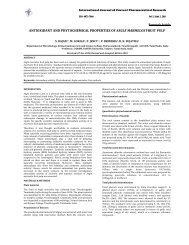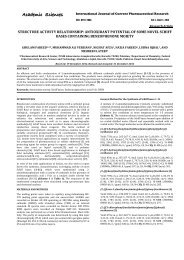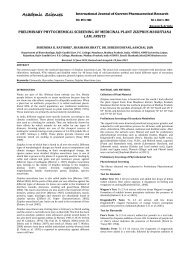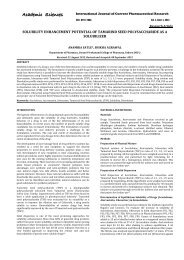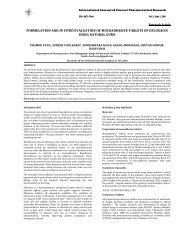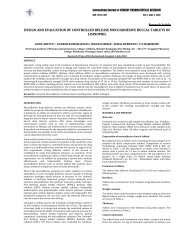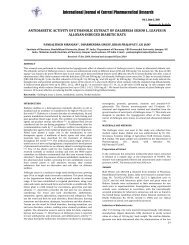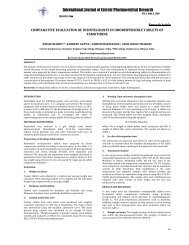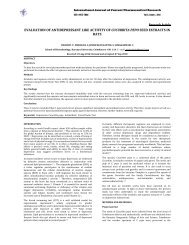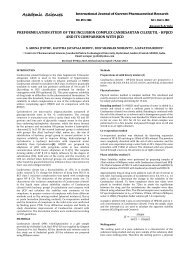cassia auriculata linn. - International Journal of Current ...
cassia auriculata linn. - International Journal of Current ...
cassia auriculata linn. - International Journal of Current ...
Create successful ePaper yourself
Turn your PDF publications into a flip-book with our unique Google optimized e-Paper software.
Academic Sciences<br />
<strong>International</strong> <strong>Journal</strong> <strong>of</strong> <strong>Current</strong> Pharmaceutical Research<br />
ISSN- 0975-7066 Vol 4, Issue 3, 2012<br />
MEDICINAL VALUES OF AVARAM (CASSIA AURICULATA LINN.): A REVIEW<br />
Review Article<br />
V.JOY 1* , M.PAUL JOHN PETER 1 , J.YESU RAJ 1* , RAMESH<br />
Department <strong>of</strong> Chemistry, St. Joseph’s College (Autonomous), Tiruchirappalli, India.<br />
Received: 20 March 2012, Revised and Accepted: 27 April 2012<br />
2<br />
ABSTRACT<br />
In recent times, focus on plant research has increased all over the world and a large body <strong>of</strong> evidence has collected to show immense potential <strong>of</strong><br />
medicinal plants used in various traditional systems. Over the last few years, researchers have aimed at identifying and validating plant derived<br />
substances for the treatment <strong>of</strong> various diseases. Similarly it has been already proved that various parts <strong>of</strong> plants such as Leafs, fruits, seeds etc.<br />
provide health and nutrition promoting compounds in human diet. The Cassia <strong>auriculata</strong> Linn. is another Indian plant, which has enormous<br />
traditional uses against various diseases. The present review aims to compile medicinal values <strong>of</strong> Cassia <strong>auriculata</strong> Linn. generated through the<br />
research activity using modern scientific approaches and innovative scientific tools.<br />
Keywords: Cassia <strong>auriculata</strong> Linn., Pharmacological Activities, Medicinal Values.<br />
INTRODUCTION<br />
The use <strong>of</strong> Plants with pharmaceutical properties has received<br />
increased interest nowadays from both homeopathic and<br />
allopathic branches. These medicinal plants play an important role<br />
in public health, especially in developing countries, where it is<br />
believed that the intense utilization <strong>of</strong> plants with therapeutic<br />
action does not lead to intoxication. 1 The cost <strong>of</strong> drugs in use today<br />
is too expensive for the majority <strong>of</strong> the population in the third<br />
world countries and therefore the search for some cheap sources<br />
<strong>of</strong> antimicrobial substances in nature become inevitable. Plants<br />
are good sources for new safe, biodegradable and renewable<br />
drugs. The use <strong>of</strong> plants as therapeutic agents in addition to being<br />
used as food is age long.<br />
Though the therapeutic uses <strong>of</strong> plants by the primitive people lack<br />
scientific explanations 2 , there is a great awareness in the use and<br />
significance <strong>of</strong> these medicinal floras by the World Health<br />
Organization in several resource- poor nations. 3 This has led to<br />
intensified efforts on the documentation <strong>of</strong> medicinal plants.<br />
4<br />
C. <strong>auriculata</strong> (family: Cesalpinaceae) is a common plant in Asia,<br />
pr<strong>of</strong>oundly used in Ayurvedic medicine as a tonic, astringent and as<br />
a remedy for diabetes,conjunctivitis and opthalmia.<br />
5<br />
It is one <strong>of</strong> the<br />
principle constituents <strong>of</strong> ‘Avaarai panchaga chooranam’- an Indian<br />
herbal formulation used in the treatment <strong>of</strong> diabetes to control the<br />
blood sugar level.<br />
6<br />
Plant Description: Avaram (Cassia <strong>auriculata</strong> Linn), family<br />
Caesalpiniaceae, is also known as Avaram tree, The leaves are<br />
alternate, stipulate, paripinnate compound, very numerous, closely<br />
placed, rachis 8.8-12.5 cm long, narrowly furrowed, slender,<br />
pubescent, with an erect linear gland between the leaflets <strong>of</strong> each<br />
pair, leaflets 16-24, very shortly stalked 2-2.5 cm long 1-1.3 cm<br />
broad, slightly overlapping, oval oblong, obtuse, at both ends,<br />
mucronate, glabrous or minutely downy, dull green, paler beneath,<br />
stipules very large, reniform-rotund, produced at base on side <strong>of</strong><br />
next petiole into a filliform point and persistent.<br />
Its flowers are irregular, bisexual, bright yellow and large (nearly<br />
5 cm across), the pedicels glabrous and 2.5 cm long. The racemes are<br />
few-flowered, short, erect, crowded in axils <strong>of</strong> upper leaves so as to<br />
form a large terminal inflorescence (leaves except stipules are<br />
suppressed at the upper nodes). The 5 sepals are distinct, imbricate,<br />
glabrous, concave, membranous and unequal, with the two outer<br />
ones much larger than the inner ones. The petals also number 5, are<br />
free, imbricate, crisped along the margin, bright yellow veined with<br />
orange. The anthers number 10 verification needed and are separate, with<br />
the three upper stamens barren; the ovary is superior, unilocular,<br />
with marginal ovules.<br />
The fruit is a short legume, 7.5–11 cm long, 1.5 cm broad, oblong,<br />
obtuse, tipped with long style base, flat, thin, papery, undulately<br />
crimpled, pilose, pale brown. 12-20 seeds per fruit are carried each<br />
in its separate cavity. 7<br />
Fig. 1: Leaves and fruits <strong>of</strong> Avaram
Joy et al.<br />
Int J Curr Pharm Res, Vol 4, Issue 2, 1-3<br />
Chemical Constituents: Various phytoconstituents have been isolated from the various parts <strong>of</strong> Cassia <strong>auriculata</strong> Linn., which may be categorized<br />
as[8]<br />
Table1: Phytoconstituents isolated from various parts <strong>of</strong> Cassia <strong>auriculata</strong> Linn.<br />
S. No. Part Phytoconstituents<br />
1. Leaf fatty acid esters, fatty acid amide, triterpene, diterpene alcohols and phytol<br />
2. Flower terpenoids, tannin, flavonoids, saponin, cardiac glycosides and steroids<br />
3. Seed Grape seed oil, n-Hexadecanoic acid ,9-Octadecenoic acid, (E)- ,E,Z-1,3,12-Nonadecatriene , Stearic acid<br />
Traditional Uses <strong>of</strong> Bael Tree Parts for Medicinal Purpose<br />
Cassia <strong>auriculata</strong> L. commonly known as tanner's <strong>cassia</strong>, also known<br />
as “avaram” in Tamil language is a shrub belongs to the<br />
Caesalpiniaceae family. The shrub is specially famous for its<br />
attractive yellow flowers which are used in the treatment <strong>of</strong> skin<br />
disorders and body odour. It is widely used in traditional medicine<br />
for rheumatism, conjunctivitis and diabetes. It has many medicinal<br />
properties. Its bark is used as an astringent, leaves and fruits<br />
anthelminthic, seeds used to treat in eye troubles and root employed<br />
in skin diseases. 9<br />
It is also used for the treatment <strong>of</strong> ulcers, leprosy and liver disease 10 .<br />
The antidiabetic, hypolipidemic<br />
11<br />
and antioxidant<br />
12<br />
and<br />
hepatoprotective 13 effect <strong>of</strong> Cassia <strong>auriculata</strong> have been reported. It<br />
was also observed that flower and leaf extract <strong>of</strong> Cassia <strong>auriculata</strong><br />
shown to have antipyretic activity. 14<br />
Various proved therapeutic values <strong>of</strong> Cassia <strong>auriculata</strong> Linn.<br />
1. Anti diabetic Activity: L.Pari & M.Latha have reported that, Oral<br />
administration <strong>of</strong> 0.45 g/kg body weight <strong>of</strong> the aqueous extract <strong>of</strong><br />
the flower for 30 days resulted in a significant reduction in blood<br />
glucose and an increase in plasma insulin, but in the case <strong>of</strong> 0.15 and<br />
0.30 g/kg, was not significant.[15]. They are one <strong>of</strong> the constituent <strong>of</strong><br />
polyherbal formulation ‘Diasulin’ in the concentration range <strong>of</strong> 40<br />
mg/dl which is proven to have antidiabetic activity. 16<br />
2. Hepatoprotective activity: Jeeva Jothi Dhanasekaran; Mathangi<br />
Ganapathy et al(2011) worked on Cassia <strong>auriculata</strong> Linn leaf and<br />
flowers extract on alcohol induced liver injury in albino rats and<br />
presented data <strong>of</strong> excellent hepatoprotective effects. 17<br />
3. Antibacteriall activity: S. Maneemegalai and T. Naveen et al:<br />
Studies on the antibacterial activity <strong>of</strong> ethanol, methanol and<br />
aqueous extracts <strong>of</strong> dry flower and ethanol, methanol and acetone<br />
extracts <strong>of</strong> fresh flower <strong>of</strong> Cassia <strong>auriculata</strong> was conducted using<br />
agar disc diffusion method. The microorganisms used include<br />
Staphylococcus aureus, Enterococcus faecalis, Bacillus subtilis,<br />
Salmonella typhi, Salmonella paratyphi A, Escherichia coli, Proteus<br />
mirabilis, Pseudomonas aeruginosa, Klebsiella pneumoniae, Vibrio<br />
cholerae and Shigella dysentrae. The maximum activity was observed<br />
against all organisms except Pseudomonas aeruginosa and Klebsiella<br />
pneumoniae. The minimum inhibitory concentration ranged<br />
between 12.5 mg/mL and 75mg/mL depending on microorganism<br />
and various extract. Presence <strong>of</strong> phytochemicals such as terpenoids,<br />
tannins, flavonoids, saponin, cardiac glycosides and steroids were<br />
observed. Cassia <strong>auriculata</strong> was observed to have antibacterial<br />
activity and can be used for medicinal purposes. 18<br />
4. Antipyretic Activity: L.Pari and M.Latha et al (2002) presented<br />
antipyretic properties <strong>of</strong> serial extract <strong>of</strong> leaves <strong>of</strong> Cassia <strong>auriculata</strong>,<br />
and presented that most <strong>of</strong> the extract caused a significant inhibition<br />
<strong>of</strong> Oral administration <strong>of</strong> 0.45 g/kg body weight <strong>of</strong> the aqueous<br />
extract <strong>of</strong> the flower for one day it showed good results for<br />
antipyretic activity 15 . Vedavathy and Rao has also done the similar<br />
work in the year <strong>of</strong> 1991. It showed a good resolution for the<br />
antipyretic activity19<br />
5. Antioxidant: A. Kumaran R. Joel Karunakaran et al(2007) The<br />
ethanol and methanol extracts <strong>of</strong> Cassia<strong>auriculata</strong> flowers were<br />
screened for antioxidant activity. The antioxidant activity was<br />
determined by an improved assay based on the decolorization <strong>of</strong> the<br />
radical monocation <strong>of</strong> ′ 2,2 -azinobis-(3-ethylbenzothiazoline-6-<br />
sulfonic acid) (ABTS) and 1,1-diphenyl-2-picrylhydrazyl (DPPH)<br />
radical scavenging method. The ethanol and methanol extracts <strong>of</strong> C.<br />
<strong>auriculata</strong> flowers showed antioxidant activity in both assays 12 .<br />
Similar work was carried out by C Anushia, P Sampathkumar, L<br />
Ramkumar in (2009) 20<br />
6. Anthelmintic potential: Satish B. Kosalge*, Ravindra A. Fursule<br />
et al 2009.,The aqueous extract <strong>of</strong> Cassia <strong>auriculata</strong> leaves (Awali),<br />
were investigated for their anthelmintic potential against<br />
earthworms (Eicinia faeteda), tapeworms(Raillietina spiralis ) and<br />
roundworms(Ascardia galli). Various concentrations (10-50 mg/ml)<br />
<strong>of</strong> each plant extract were tested in the bioassay and different<br />
parameters such as determination <strong>of</strong> time <strong>of</strong> paralysis and time <strong>of</strong><br />
death <strong>of</strong> the worms were recorded. All the extracts exhibited<br />
significant anthelmintic activity at highest concentration <strong>of</strong><br />
50mg/ml. Piperazine citrate (10 mg/ml) was used as reference<br />
standard and distilled water as control 21 . Similar work was reported<br />
by Sucheta A Gaikwad*, Asha A. Kale, Balaso. G. Jadhav, Nirmala. R.<br />
Deshpande and Jyoti. P. Salvekar in the year <strong>of</strong> 2011 22<br />
7. Diuretic Activity (PS Kumar, S Sucheta, VS Deepa, P Selvamani, S<br />
Latha.,) et al The study was carried out to determine the antioxidant<br />
activity <strong>of</strong> Cassia <strong>auriculata</strong> by inhibition <strong>of</strong> lipid peroxidation<br />
technique. The highest inhibition <strong>of</strong> lipid peroxidation activity was<br />
observed in C.<strong>auriculata</strong> (89%). The potency <strong>of</strong> protective effect <strong>of</strong><br />
C.<strong>auriculata</strong> was about 3 times greater than the synthetic<br />
antioxidant butylated hydroxy toluene (BHT). The total alkaloid<br />
content varied from 24.6 ± 0.18 to 72.6 ± 2 mg g-1 in the extracts.<br />
Flavanoid contents were between 23.15 ± 0.2 and 63.3 ± 0.6 mg g-1<br />
in the methanolic extracts <strong>of</strong> these plants. Our study indicates that<br />
the antioxidant activity <strong>of</strong> C.<strong>auriculata</strong> could be harnessed as a drug<br />
formulation. 23<br />
8. Liver injury: Activity <strong>of</strong> Cassia<strong>auriculata</strong> leaf extract in rats with<br />
alcoholic liver injury was reported by(Senthil Kumar Rajagopal<br />
Ponmozhi Manickam Viswanathan Periyasamy Nalini<br />
Namasivayam) 24<br />
9. Antiulcer Activity: The present study was carried out to evaluate<br />
the anti-ulcer activity <strong>of</strong> <strong>cassia</strong> <strong>auriculata</strong> leaf extract against<br />
pylorous ligation induced gastric ulcer. The methanolic leaf extract<br />
<strong>of</strong> <strong>cassia</strong> <strong>auriculata</strong> at dose <strong>of</strong> 300 mg/kg p.o. markedly decrease the<br />
incidence <strong>of</strong> ulcers in pyloric ligatied rats. In pyloric ligated rats,<br />
there was an increase in the gastric volume, free and total acidity<br />
and ulcerative index as compared to the control group. The<br />
methanolic leaf extract <strong>of</strong><strong>cassia</strong> <strong>auriculata</strong> at dose <strong>of</strong>, 300 mg/kg<br />
showed significant reduction in the above parameters which was<br />
comparable to the standard drug famotidine (10 mg/kg). Cassia<br />
<strong>auriculata</strong> extract showed protection index 79.4 %, whereas<br />
standard drug famotidine showed protection index.<br />
25<br />
10. Toxicity Studies: The present investigation was carried out to<br />
evaluate the safety <strong>of</strong> aqueous extract <strong>of</strong> Cassia <strong>auriculata</strong> seeds by<br />
determining its potential toxicity after acute and subacute<br />
administration in rats. For acute study, aqueous extract <strong>of</strong> Cassia<br />
<strong>auriculata</strong> seeds was administered to rats in single dose <strong>of</strong> 0-5000<br />
mg/kg given by the gavage and Monitored behavioral changes,<br />
adverse effects, body weight changes and mortality were<br />
determined for up to 14 days. At the end <strong>of</strong> the observation period<br />
animals were sacrificed and subjected to gross necropsy study. In<br />
the sub acute dose study the extract was administered orally at<br />
doses <strong>of</strong> 0, 1000 and 2000mg/kg daily for 28days to rats and<br />
biochemical, hematological parameters and histopathological study<br />
carried out after 28 days <strong>of</strong> oral administration. In the acute study <strong>of</strong><br />
aqueous extract <strong>of</strong> Cassia <strong>auriculata</strong> seeds did not show any<br />
behavioral changes sign <strong>of</strong> adverse effects or deaths.<br />
26<br />
2
Joy et al.<br />
Int J Curr Pharm Res, Vol 4, Issue 2, 1-3<br />
11. Other reported medicinal values: Kumar et al, 2002., It also<br />
possesses medicinal properties: the bark is astringent, leaves and<br />
fruits anthelminthic, seeds used in eye troubles and root employed<br />
in skin diseases. It has been used for the treatment <strong>of</strong> ulcers, leprosy<br />
and liver disease. 27 .<br />
CONCLUSION<br />
It is quite evident from this review that Cassia <strong>auriculata</strong> contains a<br />
number <strong>of</strong> phytoconstituents which reveals its uses for various<br />
therapeutic purposes. The Plant or its individual parts can be used<br />
for the treatment <strong>of</strong> various disorders in human being such as,<br />
diabetes, liver toxicity, fungal infection, microbial infection,<br />
inflammation, pyrexia and to relieve pain. Still, so much work is<br />
required with the Cassia <strong>auriculata</strong> to investigate the mechanism <strong>of</strong><br />
actions with other therapeutic activities.<br />
REFERENCES<br />
1. Mossi, A.J. Mazutti, Paroul, M., Corazza, N., Dariva, M.L., Cansian,<br />
C. & Oliveira, R.L. (2009). Chemical variation <strong>of</strong> tannins and<br />
triterpenes in Brazilian populations <strong>of</strong> Maytenus ilicifolia Mart.<br />
Ex Reiss Brazilian <strong>Journal</strong> <strong>of</strong> Biology 69 (2).<br />
http://dx.doi.org/10.1590/S1519-69842009000200015<br />
2. Dutta, A.C. Botany for degree students. Oxford University Press,<br />
London, 1994; 73.<br />
3. WHO. WHO traditional medicine strategy 2002- 2005. WHO,<br />
Geneva, 2002.<br />
4. Perumal, S.R & Ignacimuthu, S. (2000). Antibacterial activity <strong>of</strong><br />
some folklore medicinal plants used by tribes in Western chats<br />
<strong>of</strong> India. J.Ethanopharmacol., 69: 63-71.<br />
5. 5.Joshi SG. Cesalpinaceae. Text book <strong>of</strong> medicinal plants. Oxford<br />
and IBH Publishing; 2000: pp.119.<br />
6. Brahmachari HB, Augsti KT. Hypoglycemic agents from<br />
indigenous plants. J Pharmacol 1961; 13: 381.<br />
7. DASSANAYAKE, M.D. & FOSBERG, F.R. (EDS.) (1981): A Revised<br />
Handbook to the Flora <strong>of</strong> Ceylon (Vol. II). Smithsonian<br />
Institution and National Science Foundation, Washington D.C.,<br />
Amerind Publishing Co Pvt Ltd, New Dellhi<br />
8. Anandan1, R. Eswaran1, A.Doss2, G. Sangeetha3 and S. P.<br />
Anand2*Chemical Compounds Investigation <strong>of</strong> Cassia<br />
<strong>auriculata</strong> Leaves – A Potential Folklore Medicinal Plant.,<br />
Bulletin <strong>of</strong> Environment, Pharmacology & Life Sciences Volume<br />
1, Issue 1, December 2011: 20-23<br />
9. Siva, R. and Krishnamurthy, K.V. 2005. Isozyme diversity in<br />
Cassia <strong>auriculata</strong> L, African J <strong>of</strong> Biotechnology 4: 772-775.<br />
10. Kumar, R.S., Ponmozhi, M. and Nalini, M. 2002 . Effect <strong>of</strong> Cassia<br />
<strong>auriculata</strong> leaf extract on lipids in rats with alcoholic liver<br />
injury, Asia Pacific J <strong>of</strong> Clinical Nutrition 11: 157-163.<br />
11. Umadevi, P., Selvi, S., Suja, S., Selvam, K. and Chinnaswamy, P.<br />
2006. Antidiabetic and hypolipidemic effect <strong>of</strong> Cassia<br />
<strong>auriculata</strong> in alloxan induced diabetic rats, <strong>International</strong> J <strong>of</strong><br />
Pharmacology 2: 601-607.<br />
12. Kumaran, A., Joel Karunakaran, R. 2007. Antioxidant activity <strong>of</strong><br />
Cassia <strong>auriculata</strong> flowers, Fitoterapia 78: 46-47.<br />
13. Kumar, R.S., Ponmozhi, M., Viswanathan, P. and Nalini, N. 2003.<br />
Activity <strong>of</strong> Cassia <strong>auriculata</strong> leaf extract in rats with alcoholic<br />
liver injury, J <strong>of</strong> Nutritional Biochemistry 14: 452-458.<br />
14. Vedavathy, S. and Rao, K.N. 1991. Antipyretic activity <strong>of</strong> six<br />
indigenous medicinal plants <strong>of</strong> Tirumala hills, J <strong>of</strong><br />
Ethanopharmacology 33: 193-196.<br />
15. L Pari, M Latha Effect <strong>of</strong> Cassia Auriculata Flowers on Blood<br />
Sugar Levels, Serum and Tissue Lipids in Streptozotocin<br />
Diabetic Rats Singapore Med J 2002 Vol 43(12) : 617-621<br />
16. Basu and Kirtikar. Indian Medicinal Plants. Vol. II, Second edition<br />
.<strong>International</strong> Book distributors Dehradun India; 1935: 867-868.<br />
17. Jeeva Jothi Dhanasekaran ; Mathangi Ganapathy .,<br />
Hepatoprotective Effect <strong>of</strong> Cassia <strong>auriculata</strong> L. Leaf Extract on<br />
Carbon Tetrachloride Intoxicated Liver Damage in Wister<br />
Abino rats., Asian Journnal <strong>of</strong> Biochemistry 6 (1):104-112,2011<br />
18. S. Maneemegalai 1 * and T. Naveen .,Evaluation <strong>of</strong> Antibacterial<br />
Activity <strong>of</strong> Flower Extracts <strong>of</strong> Cassia <strong>auriculata</strong><br />
L.Ethnobotanical Leaflets 14: 182- 92, 2010.<br />
19. Vedavathy, S. and Rao, K.N. 1991. Antipyretic activity <strong>of</strong> six<br />
indigenous medicinal plants <strong>of</strong> Tirumala hills, J <strong>of</strong><br />
Ethanopharmacology 33: 193-196.<br />
20. C. Anushia, P. Sampathkumar and L. Ramkumar., Antibacterial<br />
and Antioxidant Activities in Cassia <strong>auriculata</strong>., Global <strong>Journal</strong><br />
<strong>of</strong> Pharmacology, 3 (3): 127-130, 2009<br />
21. Satish B. Kosalge*, Ravindra A. Fursule., Investigation <strong>of</strong><br />
anthelmintic potential <strong>of</strong> some plants claimed by tribals <strong>of</strong><br />
satpuda hills., <strong>International</strong> <strong>Journal</strong> <strong>of</strong> PharmTech Research<br />
ISSN : 0974-4304 Vol.1,No.1,pp 68-72, Jan – March 2009<br />
22. Sucheta A Gaikwad*, Asha A. Kale, Balaso. G. Jadhav, Nirmala. R.<br />
Deshpande and Jyoti.<br />
23. P. Salvekar., Anthelmintic activity <strong>of</strong> Cassia <strong>auriculata</strong> L.<br />
extracts-In vitro study., Scholars Research Library J. Nat. Prod.<br />
Plant Resour., 2011, 1 (2): 62-66<br />
24. PS Kumar, S Sucheta, VS Deepa, P Selvamani, S Latha.,<br />
Antioxidant activity in some selected Indian medicinal plants.,<br />
African <strong>Journal</strong> <strong>of</strong> Biotechnology > Vol 7, No 12 (2008)<br />
25. Senthil Kumar Rajagopal Ponmozhi Manickam Viswanathan<br />
Periyasamy Nalini Namasivayam Activity <strong>of</strong> Cassia<strong>auriculata</strong> leaf<br />
extract in rats with alcoholic liver injury The <strong>Journal</strong> <strong>of</strong><br />
Nutritional Biochemistry., Volume 14, Issue 8, August 2003,<br />
Pages 452–458<br />
26. Ahmed M, Rao SA, Thayyil HA, Ahemad RS, Abid M, Ibrahim M<br />
<strong>Journal</strong>Pharmacognosy <strong>Journal</strong> Volume2 Issue16<br />
Pagination48-52 Date Published11/2010<br />
27. Dr. R. Senthil selvi , S. Gopalakrishanan, T. Sivakumar, M.<br />
Ramajayam, Rahul Soman., ACUTE AND SUBACUTE TOXICITY<br />
STUDY OF AQUEOUS EXTRACT OF CASSIA AURICULATA SEEDS<br />
(CAESALPINIACEAE)., "<strong>International</strong> <strong>Journal</strong> <strong>of</strong> Pharmaceutical<br />
Research and Development" Article No. 7May-2010/Volume-<br />
2/Issue-3/ArticleNo-7<br />
3


